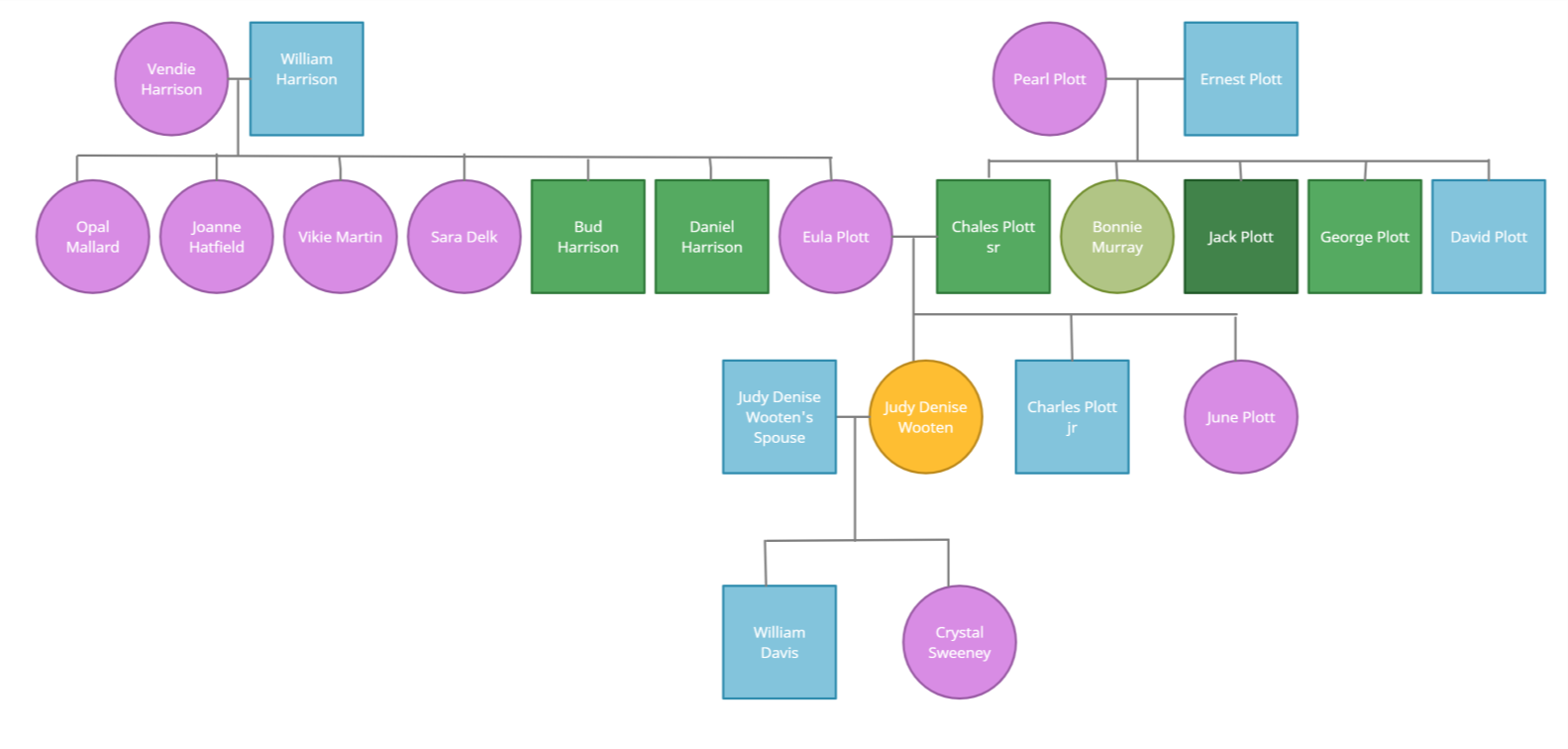According to the genogram presented above, it is seen that Judy (40-49) has hypertension and bipolar disorder. Her mother, who is still living, had Alzheimer’s at 60 years or older, Type two Diabetes, Coronary Artery Disease, and High Cholesterol at 30-39 years, Angina at 40-49, COPD at 60 years and older, and Depression at 50-59 years. Her father died from Lung Cancer at 60 years and older. Her maternal grandmother died from a Stroke at 60 years and older, had a Heart Attack and Osteoporosis at 60 years and older. Judy’s maternal grandfather died from a Heart Attack at 60 years and older and had a Stroke at 60 years and older. Her paternal grandmother died from Stroke 60 years or older; her paternal grandfather died from a Heart Attack 60 years or older and had a Clotting Disorder.

Judy’s living brother had Asthma in childhood; her living maternal aunt had Diabetes at 50-59 years. Her other maternal aunt had Leukemia at 50-59 and Personality Disorder. Judy’s maternal uncle died from Lung Cancer at 50-59 years; her other maternal uncle died from Esophageal Cancer 60 years and older. Judy’s paternal aunt died from Lung Cancer at 50-59 years, her paternal uncle died from Lung Cancer at 60 years and older, had a Stroke at 60 years and older, and Dementia. Judy’s other paternal uncle died from Lung Cancer at 60 years and older. Judy’s living paternal uncle has Gastrointestinal Disorder.
Since Judy has hypertension and her two grandmothers and maternal grandfather had strokes, and hypertension is one of the prerequisites for the stroke, she should take care of normalizing her blood pressure. This may be achieved by leading a healthy lifestyle, including physical activity and a specific healthy diet. Judy should be educated on how high blood pressure can lead to stroke and have periodical screenings for stroke risks. A heart attack also correlates with hypertension, so Judy should include foods to reduce a heart attack risk (“Hypertension guideline resources,” 2017). She also needs to be educated on how hypertension leads to a heart attack.
Then, Judy should make a simple blood sample-based genetic test that can identify women with a high risk of osteoporosis since Judy’s maternal grandmother had osteoporosis and this illness has a strong genetic component. Judy’s father, aunt, and uncles on maternal and paternal sides died from lung cancer. Although smoking is the primary reason for this illness, many people who never smoke may have this cancer. Genes and environment increase the risk for lung cancer; therefore, Judy should be aware of the risk, but she does not have to get screening tests, since, in the US, they are recommended only for people who are 50-80 years and are or used to be heavy smokers.
Coronary artery disease has a heritability of 40% to 60%, which means that Judy is at risk of having this illness since her mother, father, and all four grandparents had it. Therefore, Judy should take steps to prevent the disease and should have periodical screenings for it. The prevention steps include quitting smoking, eating fewer foods that add to heart problems, and more foods that protect the heart, being active, keeping weights within BMI, and finding healthy outlets for stress relief. The most widespread screening for CAD is coronary calcium testing of CT that provides the image of the heart between beats; there are also alternative methods of screening.
Since Judy’s mother and father had high cholesterol levels, Judy should have blood testing to determine her cholesterol levels. However, genetic or familial hypercholesterolemia can be found only in 1 of 300 people. Judy should anyway have the testing since almost 1 in 3 adults have high cholesterol levels, mostly due to eating habits. Then, type 2 diabetes, which both Judy’s parents and maternal grandparents had, puts her in a risk group. Environmental factors also impact illness development. Genetic tests determine small risks for each of several gene mutations. However, factors like BMI, family history, high blood pressure, high cholesterol levels contribute to illness development.
Genetic testing for Alzheimer’s disease is also not compulsory, even though Judy’s mother, grandmother, and aunt had this illness. That is because only 1 or less percent of illnesses are caused by specific mutations in one of three particular genes, so the testing can give only limited information. Judy has bipolar disorder, which is a mental illness. Her mother, maternal grandmother, and sister had depression. Depression is one of the symptoms of bipolar disorder, and Judy may need treatment for depression. Modern science proposes genetic testing to determine the particular type of personalized medicine that will help cope with the illness.
References
Hypertension guideline resources. (2017). Web.